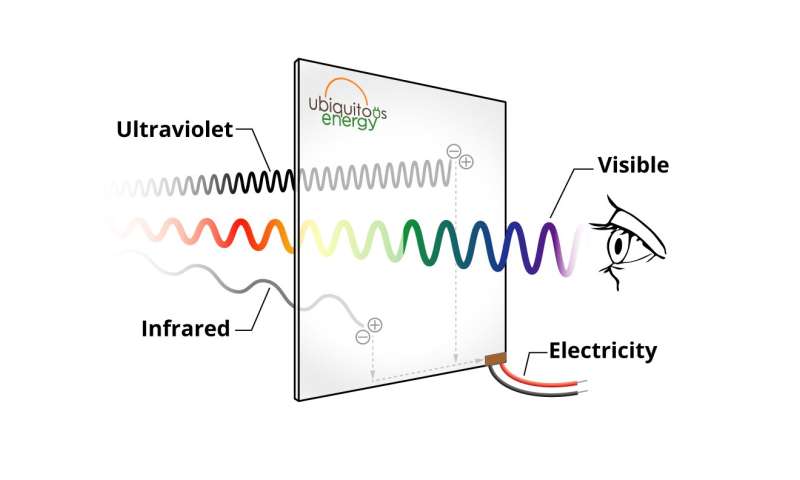by Peter Grad , Tech Xplore

Credit: Ubiquitous Energy
A Redwood City, California-based tech startup has developed a glass window packed with transparent photovoltaic cells that it believes will revolutionize the way solar energy is harnessed.
As companies around the world are increasingly working to expand and improve upon renewable energy resources, solar-energy based companies have been working to extract more energy from ever-smaller solar cells. Some resistance to the technology stemmed from the unsightly physical appearance of giant solar units placed on rooftops or vacant fields.
But Ubiquitous Energy Inc. has taken a different approach. Instead of joining competitors in trying to reduce the size of each solar cell, the company instead designed a solar panel of virtually clear glass that allows light to pass through unobstructed while tapping into the invisible ranges of the light spectrum.
Their product consists of an invisible layer of film about one one-thousandth of a millimeter thick that is layered onto existing glass components. It is clear and does not contain the blue-gray tint normally associated with solar panels.
The film, using what the company terms ClearView Power, allows the visible spectrum of light to pass through while absorbing near-infrared and ultraviolet light waves. Those waves are converted into energy. More than half of the light spectrum that can be used for energy conversion lies within those two ranges.
The panels will produce approximately two-thirds the power generated by traditional solar panels. And although installation of ClearView Power windows costs about 20 percent more than traditional windows, they are less expensive than rooftop-installed or remote solar power structures.
Miles Barr, the company's founder and chief technology officer, says he sees applications beyond merely windows in homes and office buildings.
"It can be applied to windows of skyscrapers; it can be applied to glass in automobiles; it can be applied to the glass on your iPhone," Barr said. "We really see the future of this technology as being applied everywhere, all around us, ubiquitous."
The solar units can be utilized in other everyday applications as well. Highway signage, for example, can be self-powered with these solar cells, as could supermarket shelf signage displaying product prices that can be updated at a moment's notice.
California has been a leader in the transition to renewable energy resources. State initiatives called for 33 percent of the state's electricity to come from alternate power sources by 2020, and half of all electric needs to be met by alternate sources by 2030.
California also this year began requiring all new homes to include some form of solar energy technology.
Explore furtherNew record could usher in new era for solar energy
A Redwood City, California-based tech startup has developed a glass window packed with transparent photovoltaic cells that it believes will revolutionize the way solar energy is harnessed.
As companies around the world are increasingly working to expand and improve upon renewable energy resources, solar-energy based companies have been working to extract more energy from ever-smaller solar cells. Some resistance to the technology stemmed from the unsightly physical appearance of giant solar units placed on rooftops or vacant fields.
But Ubiquitous Energy Inc. has taken a different approach. Instead of joining competitors in trying to reduce the size of each solar cell, the company instead designed a solar panel of virtually clear glass that allows light to pass through unobstructed while tapping into the invisible ranges of the light spectrum.
Their product consists of an invisible layer of film about one one-thousandth of a millimeter thick that is layered onto existing glass components. It is clear and does not contain the blue-gray tint normally associated with solar panels.
The film, using what the company terms ClearView Power, allows the visible spectrum of light to pass through while absorbing near-infrared and ultraviolet light waves. Those waves are converted into energy. More than half of the light spectrum that can be used for energy conversion lies within those two ranges.
The panels will produce approximately two-thirds the power generated by traditional solar panels. And although installation of ClearView Power windows costs about 20 percent more than traditional windows, they are less expensive than rooftop-installed or remote solar power structures.
Miles Barr, the company's founder and chief technology officer, says he sees applications beyond merely windows in homes and office buildings.
"It can be applied to windows of skyscrapers; it can be applied to glass in automobiles; it can be applied to the glass on your iPhone," Barr said. "We really see the future of this technology as being applied everywhere, all around us, ubiquitous."
The solar units can be utilized in other everyday applications as well. Highway signage, for example, can be self-powered with these solar cells, as could supermarket shelf signage displaying product prices that can be updated at a moment's notice.
California has been a leader in the transition to renewable energy resources. State initiatives called for 33 percent of the state's electricity to come from alternate power sources by 2020, and half of all electric needs to be met by alternate sources by 2030.
California also this year began requiring all new homes to include some form of solar energy technology.
Explore furtherNew record could usher in new era for solar energy
More information: ubiquitous.energy/
ubiquitous.energy/technology/
No comments:
Post a Comment